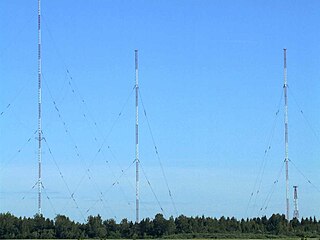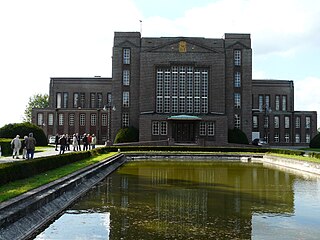
Shortwave radio is radio transmission using radio frequencies in the shortwave bands (SW). There is no official definition of the band range, but it always includes all of the high frequency band (HF), which extends from 3 to 30 MHz ; above the medium frequency band (MF), to the bottom of the VHF band.

Medium wave (MW) is a part of the medium frequency (MF) radio band used mainly for AM radio broadcasting. The spectrum provides about 120 channels with more limited sound quality than FM stations on the FM broadcast band. During the daytime, reception is usually limited to more local stations, though this is dependent on the signal conditions and quality of radio receiver used. Improved signal propagation at night allows the reception of much longer distance signals. This can cause increased interference because on most channels multiple transmitters operate simultaneously worldwide. In addition, amplitude modulation (AM) is often more prone to interference by various electronic devices, especially power supplies and computers. Strong transmitters cover larger areas than on the FM broadcast band but require more energy and longer antennas. Digital modes are possible but have not reached momentum yet.

Very low frequency or VLF is the ITU designation for radio frequencies (RF) in the range of 3–30 kHz, corresponding to wavelengths from 100 to 10 km, respectively. The band is also known as the myriameter band or myriameter wave as the wavelengths range from one to ten myriameters. Due to its limited bandwidth, audio (voice) transmission is highly impractical in this band, and therefore only low data rate coded signals are used. The VLF band is used for a few radio navigation services, government time radio stations and for secure military communication. Since VLF waves can penetrate at least 40 meters (131 ft) into saltwater, they are used for military communication with submarines.
Low frequency (LF) is the ITU designation for radio frequencies (RF) in the range of 30–300 kHz. Since its wavelengths range from 10–1 km, respectively, it is also known as the kilometre band or kilometre waves.

Medium frequency (MF) is the ITU designation for radio frequencies (RF) in the range of 300 kilohertz (kHz) to 3 megahertz (MHz). Part of this band is the medium wave (MW) AM broadcast band. The MF band is also known as the hectometer band as the wavelengths range from ten to one hectometers. Frequencies immediately below MF are denoted as low frequency (LF), while the first band of higher frequencies is known as high frequency (HF). MF is mostly used for AM radio broadcasting, navigational radio beacons, maritime ship-to-shore communication, and transoceanic air traffic control.

In radio, longwave, long wave or long-wave, and commonly abbreviated LW, refers to parts of the radio spectrum with wavelengths longer than what was originally called the medium-wave broadcasting band. The term is historic, dating from the early 20th century, when the radio spectrum was considered to consist of longwave (LW), medium-wave (MW), and short-wave (SW) radio bands. Most modern radio systems and devices use wavelengths which would then have been considered 'ultra-short'.

The American Forces Network (AFN) is a government television and radio broadcast service the U.S. military provides to those stationed or assigned overseas, and is headquartered at Fort George G. Meade, Maryland. AFN comprises two subordinate overseas commands and one directorate in the continental United States. Overseas, AFN Europe is headquartered at Sembach Kaserne, Germany and consists of 15 subordinate stations in the countries of Bahrain, Belgium, Cuba, Germany, Greece, Italy, Spain, and Turkey. AFN Pacific is headquartered at Yokota Air Base, Japan and consists of nine stations in the countries of Diego Garcia, Japan, and South Korea. Stations under AFN Europe and AFN Pacific conduct live local radio shows 12 hours a day Monday through Friday, with the exception of U.S. federal holidays. Stateside, AFN's broadcast operations, which include global radio and television satellite feeds, emanate from the AFN Broadcast Center/Defense Media Center in Riverside, California.

RIAS was a radio and television station in the American Sector of Berlin during the Cold War. It was founded by the US occupational authorities after World War II in 1946 to provide the German population in and around Berlin with news and political reporting.
Vatican Radio is the official broadcasting service of Vatican City.
The Orfordness transmitting station was a major radio broadcasting facility at Orford Ness on the Suffolk coast in the United Kingdom able to broadcast to much of Europe. It closed in May 2012 after more than 30 years of service. In 2017 Radio Caroline started broadcasting from the site, though not with the same intended coverage of an audience in Europe as the original station.

Sitkūnai Radio Station is a large facility for medium wave and shortwave broadcasting at Sitkūnai, Lithuania. The decision to build a new transmitting centre near the village of Sitkunai, about 17 km (11 mi) north of Kaunas was made by the Government of Lithuania in 1937. The building works started in 1939, and after completion, a 120 kW medium wave transmitter from Standard Telephones and Cables in the United Kingdom was ordered. However, the outbreak of World War II stopped the shipment. The empty transmitter buildings in Sitkunai survived the war with almost no damage and were used as a military compound by the German army in 1941–1944, and later as a primary school. Because the Soviet Lithuania was badly covered by radio signals, the Soviet authorities decided to continue the building work at Sitkunai and turn the site into a main shortwave and medium wave transmitting centre. During 1951 and 1952 two 50 kW shortwave transmitters, dismantled from an East German utility site as war reparations were installed in Sitkūnai. Several curtain antennas were erected and one 150 kW mediumwave transmitter was installed (665 kHz). During the January Events in 1991, Sitkūnai Radio Station was among those transmitting sites broadcasting to the world about the Soviet military actions in Vilnius when 14 civilians were killed and more than 600 injured.

The Woofferton transmitting station is owned and operated by Encompass Digital Media, as one of the BBC's assets which were handed over as part of the privatization of World Service distribution and transmission in 1997. It is the last remaining UK shortwave broadcasting site, located at Woofferton, south of Ludlow, Shropshire, England. The large site spreads across into neighbouring Herefordshire.
Kossuth Rádió is a public-broadcasting radio station in Hungary, concentrating on news and current affairs. It is one of the seven national radio channels produced by MTVA. It was established in 1925 as Rádió Budapest and named after Lajos Kossuth, a Hungarian national hero, in 1949.

Radio Ukraine International, abbreviated RUI, is the official international broadcasting station of Ukraine, with foreign language news and programming being produced by Ukrainian Radio's main editorial department for broadcasting in EBU languages. RUI broadcasts in Belarusian, Bulgarian, English, German, Hungarian, Polish, Romanian and Slovak. The Ukrainian language programming aired on RUI is produced by the domestic First Channel.

The Wiederau transmitter is the oldest broadcasting facility in Saxony. It is located near Wiederau, a village which is part of the municipality of Pegau, and is used for medium-wave, FM and Television broadcasting.

Nauen Transmitter Station in Nauen, Havelland district, Brandenburg, Germany, is the oldest continuously operating radio transmitting installation in the world. Germany's first high power radio transmitter, it was founded on 1 April 1906 by Telefunken corporation and operated as a longwave radiotelegraphy station through World War II, and during World War I became Germany's main link with the outside world when its submarine communications cables were cut. Upgraded with shortwave transmitters in the 1920s it was Germany's most advanced long range radio station, continually upgraded with the latest equipment and serving as an experimental station for Telefunken to test new technology. At the end of World War II, invading Russian troops dismantled and removed the transmitting equipment. During the Cold War it served as the GDR's international shortwave station Radio Berlin International (RBI), and was the East Bloc's second most powerful radio station, disseminating Communist propaganda to other countries. Since German Reunification in 1991 it has been operated by Deutsche Telekom, Germany's state telecommunication service. The original 1920 transmitter building designed by architect Herman Muthesius is still used; it is one of the many remaining buildings designed by that architect that is a protected cultural heritage site.
The Grigoriopol transmitter, officially the Transnistrian Radio and Television Center, is a very large broadcasting facility situated near Maiac, an urban settlement 11 km northeast of Grigoriopol, Transnistria (Moldova).

Aspidistra was a British medium-wave radio transmitter used for black propaganda and military deception purposes against Nazi Germany during World War II. At times in its history it was the most powerful broadcast transmitter in the world. Its name – after the popular foliage houseplant – was inspired by the 1938 comic song "The Biggest Aspidistra in the World", best known as sung by Gracie Fields.
Berlin-Köpenick transmitter was a transmission facility for broadcasting on medium wave, short wave, and VHF in Berlin-Köpenick, Germany, near the suburb of Uhlenhorst, after which it was occasionally named.

NAA was a major radio facility located at 701 Courthouse Road in Arlington, Virginia. It was operated by the U.S. Navy from 1913 until 1941. The station was originally constructed as the Navy's first high-powered transmitter for communicating with its bases across the U.S. and the Caribbean. During its years of operation NAA was best known for broadcasting daily time signals, however, it also provided a variety of additional services, using multiple transmitters operating on frequencies ranging from longwave to shortwave. The station also conducted extensive experimental work, including, in 1915, the Navy's first transatlantic transmission of speech.















